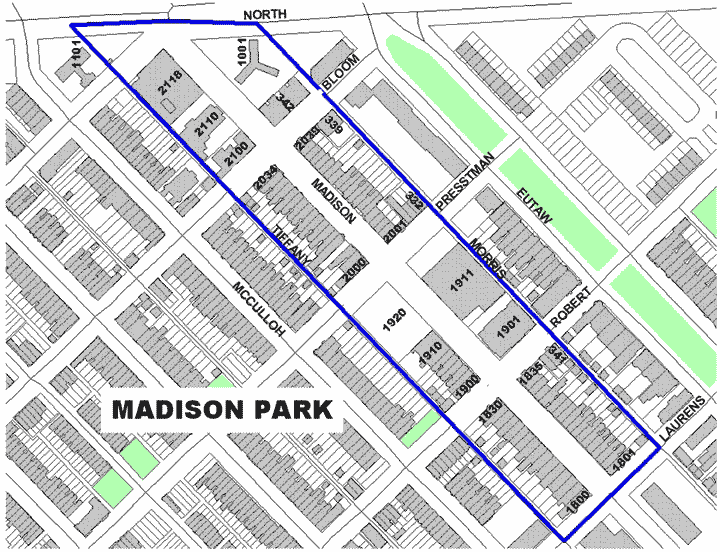Madison Park
Baltimore City Historic District Ordinance 503 9/29/77
Certified Historic District for Tax Incentives 6/16/81
Description
 The Madison Park Historic District comprises both sides of four blocks of Madison Avenue near North Avenue. Madison Avenue is a diagonally running street adjacent to Bolton Hill. The built environment of the district is primarily made up of brick row houses of an eclectic nature. Some of the houses are traditional Baltimore type row houses featuring flat facades and little detailing except for ornate bracketed cornices. Later houses feature design elements from Second Empire, Queen Anne, and Romanesque Revival styles. Mansard roofs, conical towers, projecting bays, intricate brickwork, cresting unusual window configurations, and pedimented rooflines are examples of the more eclectic styling that predominates in this area.
The Madison Park Historic District comprises both sides of four blocks of Madison Avenue near North Avenue. Madison Avenue is a diagonally running street adjacent to Bolton Hill. The built environment of the district is primarily made up of brick row houses of an eclectic nature. Some of the houses are traditional Baltimore type row houses featuring flat facades and little detailing except for ornate bracketed cornices. Later houses feature design elements from Second Empire, Queen Anne, and Romanesque Revival styles. Mansard roofs, conical towers, projecting bays, intricate brickwork, cresting unusual window configurations, and pedimented rooflines are examples of the more eclectic styling that predominates in this area.
Besides the row housing, the district includes some significant individual buildings, such as the Belview-Manchester Apartments and the old Madison Avenue Temple, an excellent design modeled after Byzantine architecture.
Significance
The Madison Park Historic District is significant as a relatively intact neighborhood embodying the distinctive architectural characteristics of eclectic row houses. These buildings feature important architectural elements which typify the growing interest that Baltimore architects and builders had in emerging architectural styles and the manner in which they incorporated new elements into the traditional Baltimore row house.
The Madison Park area is associated with important local builders, such as Francis E. Yewell, and important local architects, such as Charles L. Carson, who were responsible for the buildings in Madison Park. This area was a predominantly Jewish neighborhood at the turn of the century and later one of the first black middle class neighborhoods. Many influential Jewish and African-American businessmen who lived in Madison Park played a role in the development of Baltimore businesses and industries.